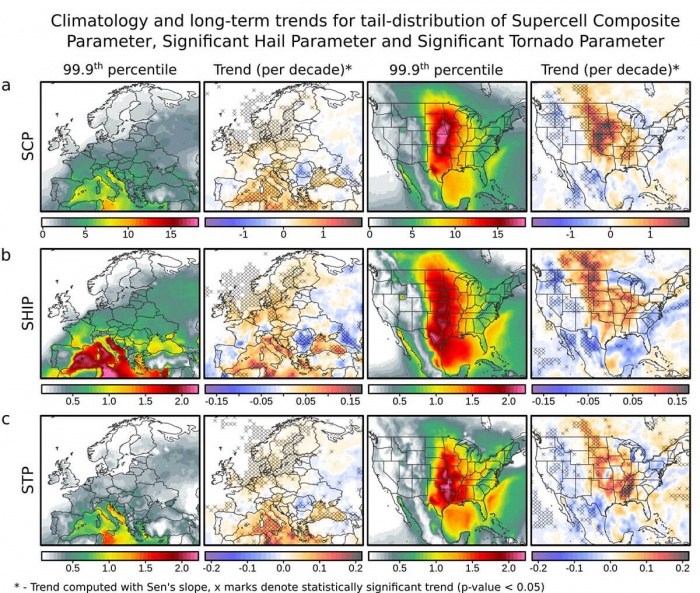A recently released research article published in the Bulletin of the American Meteorological Society indicates that stronger convective inhibition causes declines in the frequency of thunderstorms over the United States, while a substantial increase in low-level moisture supports more thunderstorm activity over southern, central, and northern Europe.
In the article Differing trends in the United States and European severe thunderstorm environments in a warming climate lead by Dr. Mateusz Taszarek, researchers used 41 years of ECMWF ERA5 reanalysis data to investigate how convective environments across Europe and the United States have changed during an era of rapidly increasing global temperatures.
Hourly ERA5 data and 137 vertical levels allowed the characterization of convective environments in the way that was not possible with prior reanalyses, particularly accounting for better representation of the diurnal cycle, and boundary-layer conditions.
Trends in commonly used parameters
Researchers placed the main focus on parameters commonly used in the operational forecasting of thunderstorms: low-level mixing ratio, temperature lapse rates, convective available potential energy (CAPE), convective inhibition (CIN), vertical wind shear, and storm-relative helicity.
Europe
Over Europe, a pronounced multidecadal increase in low-level temperature and moisture has produced positive trends in CAPE over the southern, central, and northern parts of the continent, with minor decreases over the Iberian Peninsula. The strongest positive trends occurred over the Mediterranean and the Black Sea.
Changes to wind shear and storm-relative helicity (limited to unstable situations), turned out to be mostly insignificant, with modest increases over northwestern Europe and decreases over the south and southeast.
United States
In comparison, CAPE over the United States has been surprisingly decreasing over the majority of southern and western portions of the country, while a robust surge in CIN was observed over the Great Plains. However, a modest increase in vertical wind shear and storm-relative helicity has been also observed over the Great Plains.
As stated in the article: “Substantial changes in CIN can be partially explained by the robust increases in lapse rates over western mountainous regions and subsequent advection of an elevated mixed-layer over the lower elevations of the continent (especially southern and central Great Plains). This process may lead to a more stable stratification between the boundary layer and the EML, and hence stronger CIN as a result. Substantial increases in CIN suggest that convective initiation may be delayed within the diurnal cycle, precluded in totality, or lead to explosive convective initiation with severe weather.”
In addition to exploring trends, ERA5 allowed for an estimate of the underlying climatology of situations favorable to a thunderstorm, severe thunderstorm, and tornadic thunderstorm development across both continents.
Europe
The largest increases in severe thunderstorm environment have taken place over southern Europe (mainly Italy), a location also characterized by the greatest overall severe thunderstorm threat. Increases have been also observed over central, northwestern, and northern Europe, with minor decreases over eastern Europe, mainly due to increasing CIN.
United States
Across the United States, robust increases in CIN contribute to the apparent decline in the frequency of thunderstorm environments over the western and southern portions of the country. This result is also confirmed by observed lightning data that has suggested similar decreases over a period of the last 30 years.
On the other hand, minor increases in severe thunderstorm potential have taken place over northern parts of the Great Plains during summer, and in the Southeast during winter and spring – especially for storms likely to produce tornadoes.
Extreme environments comparison
Another interesting aspect of the study is a comparison of the peak extreme environments between Europe and the United States.
Analysis of extremes in Supercell Composite Parameter, Significant Hail Parameter, and Significant Tornado Parameter indicates overall much higher values over the area of Great Plains compared to anywhere in Europe.
The best potential for extreme storm environments in Europe is mainly over Italy and the surrounding countries, the Balkan Peninsula, and southern France.
However, over both continents, there is a tendency for an increasing threat of high-end severe weather environments.
The authors conclude that analysis of the changes that have taken place over the last 4 decades, may provide a better understanding of how severe thunderstorm potential will change in the future.
Decreases in the frequency of convective initiation and resulting precipitation may have long-term implications for agriculture, water availability, and the frequency of severe weather such as large hail and tornadoes.
The lead author of the study, Dr. Mateusz Taszarek told Severe Weather Europe (SWE) that:
“While a degree of caution must be stressed when using reanalysis data, our result reinforces the hypothesis that future increases in CAPE may not necessarily lead to more frequent thunderstorms, as reductions in relative humidity and strengthening CIN can result in less efficient and frequent convective initiation.
On the other hand, stronger CIN can lead to more explosive convective initiation and promote discreet mode. As a result, we may see fewer storms, but more supercells capable of producing tornadoes and large hail. Therefore, we believe a stronger emphasis should be placed on the issue of inhibition and initiation in future analyses of trends and projections, instead of increases in CAPE”.
Recap: Thunderstorm increase in Europe, decrease in the United States
Thus, it cannot be ruled out that in future years, decreasing the overall frequency of thunderstorms across the Great Plains will be interspersed with more violent severe weather outbreaks.
While over Europe the frequency of severe thunderstorms will keep consistently increasing, with the biggest potential observed primarily over Italy and surroundings.
For further details please see the full-text of the article:
Taszarek, M., J. T. Allen, H. E. Brooks, N. Pilguj, and B. Czernecki, Differing trends in the United States and European severe thunderstorm environments in a warming climate. Bull. Amer. Meteor. Soc., doi: https://doi.org/10.1175/BAMS-D-20-0004.1.
See also…




